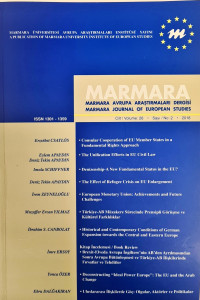Abstract
In this paper, Germany’s Foreign Policy towards the Central and Eastern Europe is going to be investigated along the contours of the framework within which historical and cultural background, fundamental means of German Foreign Policy, the pursuit of German national interests in that region and the related problems to these are to be analysed. Conceptually, the approach of conditional reality which aims to search dynamic conditions of being a political and economic power in the past and present will be used. By means of this conceptual framework, the issue of German expansion towards Balkans, and its consequences are to be analyzed. Thanks to the discernible language they speak, after they appeared with their political identity on the stage of Europe, beginning with the 10th century, Germans led the Holy Roman Empire on the one hand and expanded towards the Eastern Europe on the other hand. This German expansion towards the East, known as “Ostsiedlung-settlement in Eastern Europe”, occurred with the aid of princes, priests, and merchants. Consequently, new settlements, institutions (churches, schools, administrative structures) and commercial relations were established in Eastern Europe. Foreign policy has always had a privileged status in German politics and public administration. This is mostly related to the retrospective dispersion of Germans. It has become imperative to determine foreign policy, consistent with the features of the era. It should be stated that because of its tragic historical experiences, Germany is quite careful and cautious in its foreign policy practices. This may also have a significant function in German politics towards the Balkans. European Union’s common policies in this point have a constructive and appeasing effect. In fact, the EU system has a two-dimensional function both for Germany and Europe. The first one is the EU’s implementation of a duty of supervising Germany and stopping possible German aggression. The second one is related with and convenient for German national interests. The EU model is legitimizing German attitudes and policies towards the Europe and the Balkans. Additionally, related with the regional and global security, Germany played its first important role in this region in post-Cold War era with its military existence in 1999 during the NATO intervention to Kosovo. Because of its historical legacy, a great number of states in Central and Eastern Europe have had political prejudices against Germany. But conditional reality which has historical and contemporary foundations has directed Germany towards integration in Europe, and thus it has made social and political reconciliation within the European Union visible. The realm of German existence with political and economic influence conditionally depends on the before mentioned integration and reconciliation movements in Central and Eastern Europe.
Keywords
German principalities Ostsiedlung Central and Eastern Europe European Union conditional reality
References
- Arnold, H. (1980) Auswärtige Kulturpolitik, (München). Auswärtiges Amt, Deutsche Außenpolitik Nach der Einheit 1990-1993 (Bonn: Eine Dokumentation, 1993). Auswärtiges Amt, Unsere Auswärtige Politik (Bonn: 1985).
Abstract
References
- Arnold, H. (1980) Auswärtige Kulturpolitik, (München). Auswärtiges Amt, Deutsche Außenpolitik Nach der Einheit 1990-1993 (Bonn: Eine Dokumentation, 1993). Auswärtiges Amt, Unsere Auswärtige Politik (Bonn: 1985).
Details
| Primary Language | English |
|---|---|
| Journal Section | Makaleler |
| Authors | |
| Publication Date | December 28, 2018 |
| Published in Issue | Year 2018 Volume: 26 Issue: 2 |


